
Explore 10 Traditional Craft Villages in Hanoi.
Hanoi, with a rich history of a thousand years of culture, is home to many traditional craft villages, each carrying the story of the skilled hands and artistic soul of its artisans. Let’s explore 10 famous craft villages in Hanoi with Hanoi Larosa, where every product is a work of art.
1. Bat Trang Pottery Village
Bat Trang pottery village, with a history of over 500 years, is the largest pottery production center in the country. Located about 13 km from the center of Hanoi, Bat Trang is not only famous for its high-quality pottery products but also for the poetic beauty of its landscapes. The narrow village roads, ancient houses, and closely lined pottery workshops create a peaceful space that harmonizes art and nature.
At Bat Trang, visitors can witness the pottery-making process from preparing materials to the completion of the product. Local artisans, with their skillful hands and exquisite techniques, create a variety of products such as bowls, plates, vases, and decorative items. Each product carries the story and dedication of the craftsman, from the delicate carvings to the unique glazes.
In addition to sightseeing, visitors have the opportunity to participate in pottery-making workshops. Here, you can shape clay, paint on pottery, and see your creations fired in the kiln. This is an exciting experience that helps visitors understand more about the production process and the cultural value of traditional pottery.
Bat Trang is not just a pottery-making village but also a place that preserves many cultural and historical values. The pottery craft here has developed since the Thang Long period, when artisans created products to serve the needs of kings and officials. Despite the ups and downs of history, the pottery village has maintained its traditional craft and continues to develop.
When visiting Bat Trang, don’t forget to stop by the pottery shops to purchase unique products as gifts for family and friends. These pottery items not only have high aesthetic value but also contain deep cultural significance, exemplifying the skill and creativity of the Vietnamese people.
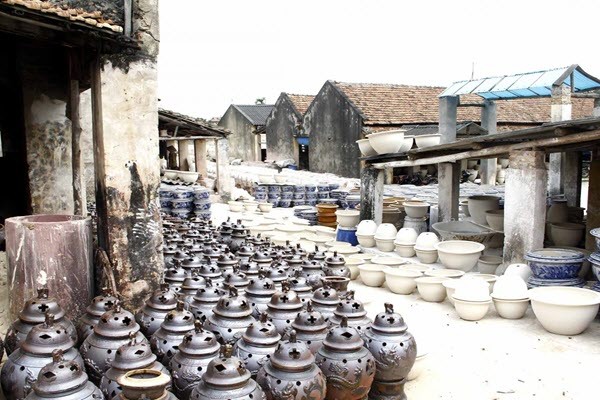
2. Ha Thai Lacquer Village
Ha Thai, located in Thường Tín District, Hanoi, is known as the cradle of lacquer art, producing products that embody the cultural identity of Vietnam. The lacquer craft here has a long-standing history and has been developed over many generations. The products from Ha Thai are not only unique in form but also carry profound meanings related to culture, beliefs, and the spirit of the Vietnamese people.

The process of making lacquerware in Ha Thai is a refined art that involves many meticulous steps. The primary material used is wood, which is carefully prepared and then coated with multiple layers of lacquer. Each layer must be dried and polished meticulously to achieve perfect shine and color. Skilled artisans not only require dexterity but also need creative thinking to transform rough pieces of wood into vibrant works of art.
Ha Thai lacquer products stand out for their combination of traditional techniques and modern styles. The patterns and motifs often reflect the influences of Vietnamese folk culture, represented through familiar images such as flowers, rural landscapes, and symbols of folk beliefs. Each product is not merely a utility item but also a piece of art that carries a rich cultural narrative.
The village of Ha Thai also hosts various cultural events, such as lacquer festivals, where visitors can participate in practical activities and learn about the traditional craft. These events not only promote the products but also contribute to preserving and developing the traditional culture of the nation.

Visitors to Ha Thai can participate in lacquer workshops, where they will be guided by experienced artisans. From selecting materials and mixing lacquer to decorating the products, each step provides a true artistic experience. This is a fantastic opportunity not only to learn but also to gain a deeper understanding of the cultural value of the lacquer craft.
3. Chuong Leaf Hat Village
Chuong Village, located in Thanh Oai District, Hanoi, is famous for its production of conical hats, a symbol of Vietnamese women. The craft of hat-making here is not just a simple trade but an integral part of the culture and spiritual life of the local people. Over many generations, this craft has been passed down and preserved, maintaining the traditional cultural values.
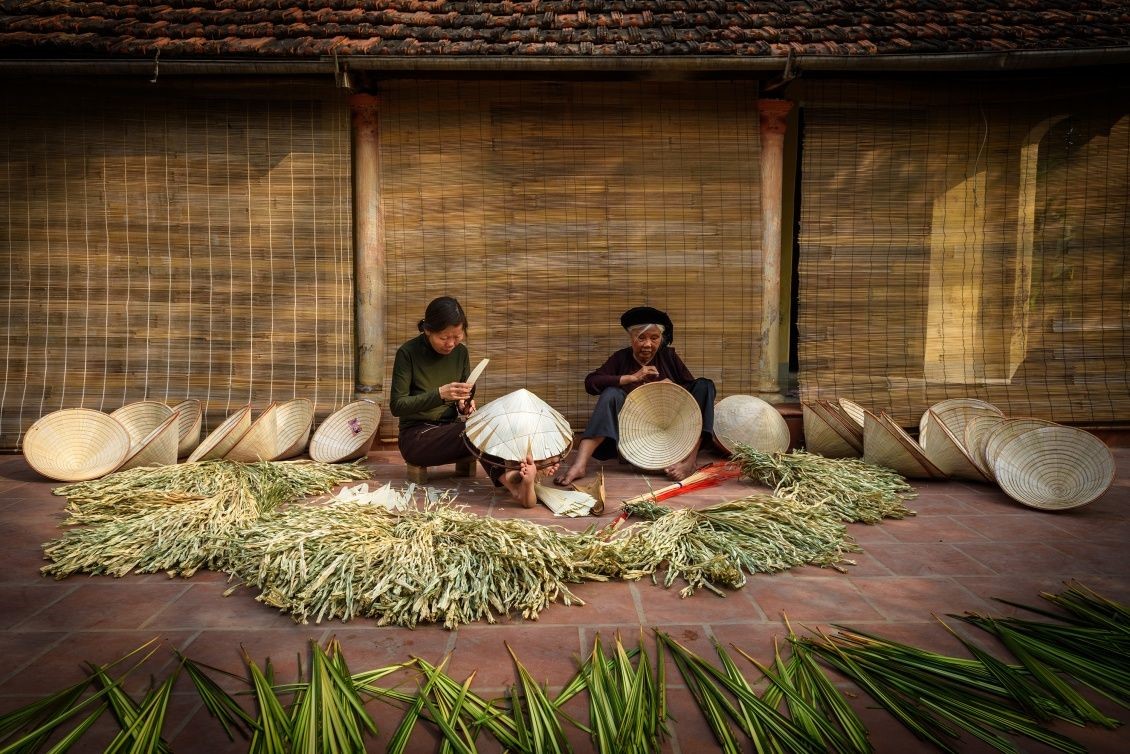
Visitors to Chuong Village not only get to admire the hat-making process but also have the opportunity to participate in experiential workshops. You can make your own conical hat, from selecting the leaves to assembling the layers together. This is an exciting experience that allows you to appreciate the effort and dedication of the artisans.
Additionally, Chuong Village is an ideal destination for cultural tours, where you can learn about local customs, enjoy traditional cuisine, and engage in various traditional activities that take place throughout the year.
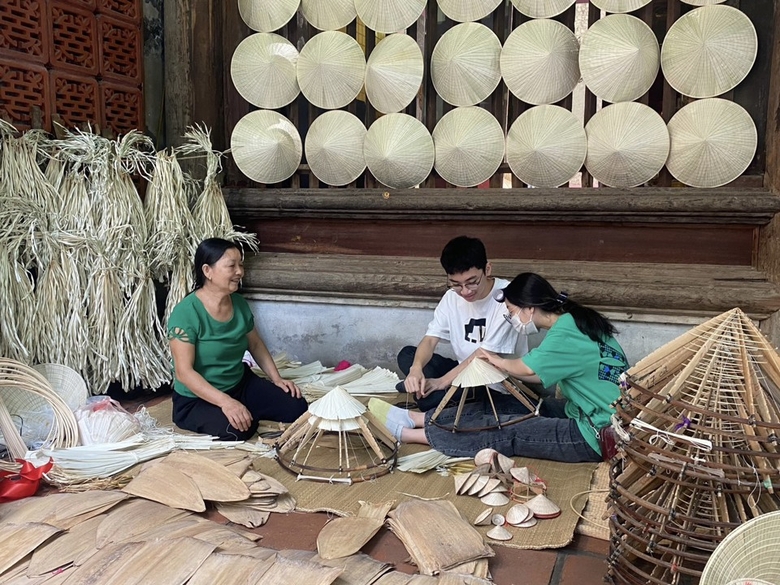
Chuong Leaf Hat Village is not just a place that produces beautiful hats; it is also a guardian of the Vietnamese cultural soul. When you touch these conical hats, you not only feel their softness and delicacy but also gain a deeper understanding of the stories, effort, and love of the artisans. Let Chuong Village leave a lasting impression on your journey to explore traditional culture.
4. Ngũ Xã Bronze Casting Village
Ngũ Xã, located by the Red River, preserves the art of Vietnamese bronze casting with a rich history and tradition. This craft village has existed for hundreds of years, becoming one of the largest centers for bronze production in Northern Vietnam. Products from Ngũ Xã, such as incense burners, Buddha statues, and ritual items, are not only highly aesthetic but also embody deep cultural and spiritual meanings for the Vietnamese people.
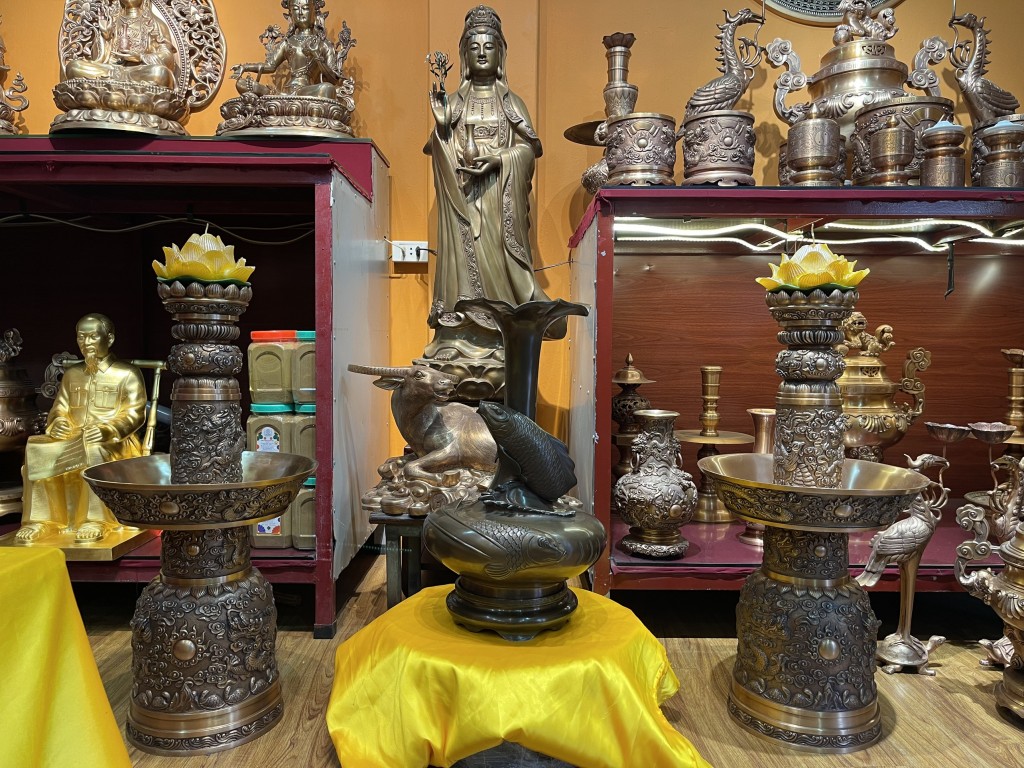

Bronze products from Ngũ Xã are often used in religious and spiritual ceremonies, such as incense burners for worship and Buddha statues for decoration in temples and pagodas. These items not only fulfill practical needs but also contribute to preserving and promoting the spiritual culture of the Vietnamese people.
Visitors to Ngũ Xã have the opportunity to tour bronze casting workshops and learn about the production process. Many artisans are eager to share their knowledge and experience, helping guests gain a deeper understanding of the cultural value of bronze casting. Additionally, you can participate in experiential workshops, where you can create small bronze items to take home as souvenirs.
5. Vạn Phúc Silk Village
Located in Hà Đông, Vạn Phúc is renowned for its traditional silk weaving. Vạn Phúc silk is not only beautiful but also durable, made from high-quality materials and a meticulous weaving process that reflects the dedication and skill of the local artisans.
Vạn Phúc Silk Village has a long-standing history, established hundreds of years ago. Silk weaving has become an indispensable part of the cultural and economic life of the local people. Artisans have preserved and developed traditional weaving techniques, creating silk products renowned both domestically and internationally.
Vạn Phúc silk is distinguished by its diverse range of designs, from traditional áo dài to scarves, handbags, and other decorative items. Its bright colors, intricate patterns, and soft texture have won the hearts of many customers.
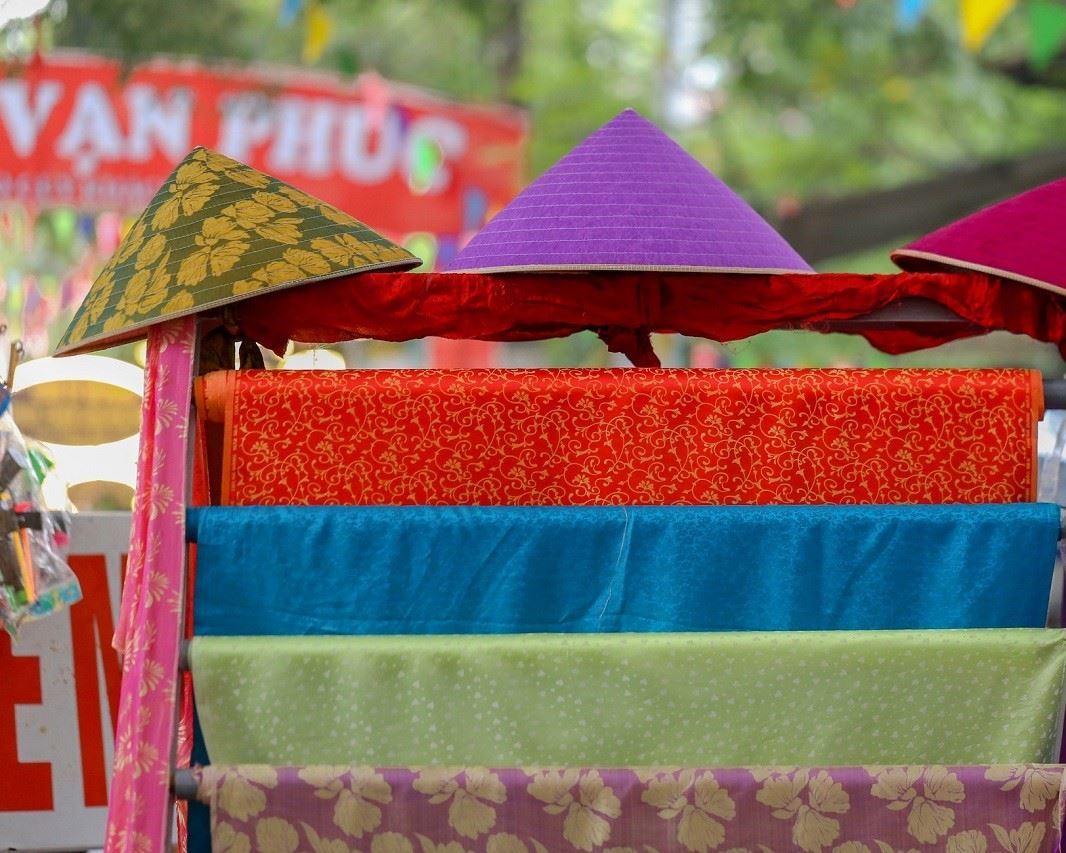
Vạn Phúc Silk Village is not only a silk production hub but also an attractive tourist destination. Visitors come not only to shop but also to learn about the silk weaving process, participate in hands-on workshops, and experience local culture. This not only helps preserve the silk weaving craft but also provides a stable source of income for the local community.
6. Quất Động Embroidery Village
Quất Động is a traditional hand-embroidery village known for its unique artistic creations. The artisans here blend classic and modern embroidery techniques to produce high-value products.
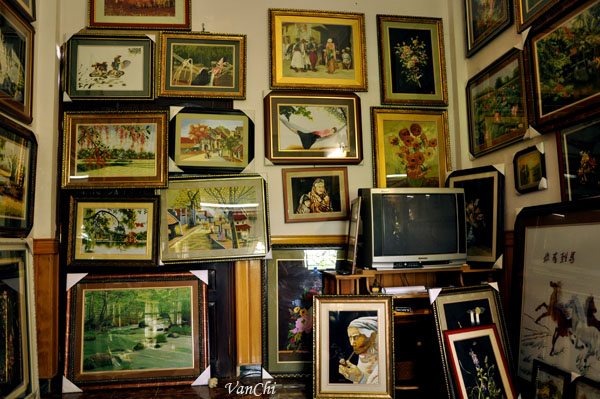
Quất Động Embroidery Village has a rich history, originating centuries ago. From its early days, the locals began developing embroidery as a way to embellish clothing and household items. Over time, this craft has evolved into a refined art form, captivating the interest of many generations.
The embroidery process in Quất Động requires meticulousness and patience. Each piece starts with a design that often reflects cultural significance and local customs. Artisans use colorful threads and various stitching techniques, such as cross-stitching and raised embroidery, to create vibrant and intricate patterns. Every stitch showcases the dedication and creativity of the craftsmen.

The hand-embroidered products from Quất Động are quite diverse, ranging from embroidered paintings and tablecloths to áo dài, handbags, and various decorative items. Each product is not only visually appealing but also carries deep cultural significance. The embroidered paintings often depict images of nature, people, and distinctive cultural symbols, making each piece unique and meaningful.
7. Cốm Vòng Village
Cốm Vòng is a specialty of autumn in Hanoi, made from young sticky rice grains. The delicious flavor of cốm has become a cultural symbol of the local cuisine.
The process of making Cốm Vòng is intricate and meticulous. First, the young sticky rice grains are harvested at the right time in autumn when they are still green, soft, and sticky. After being washed, the rice is roasted over low heat to develop its distinctive flavor. The roasting technique is crucial; if roasted too long, the cốm will become dry and lose its chewy texture.
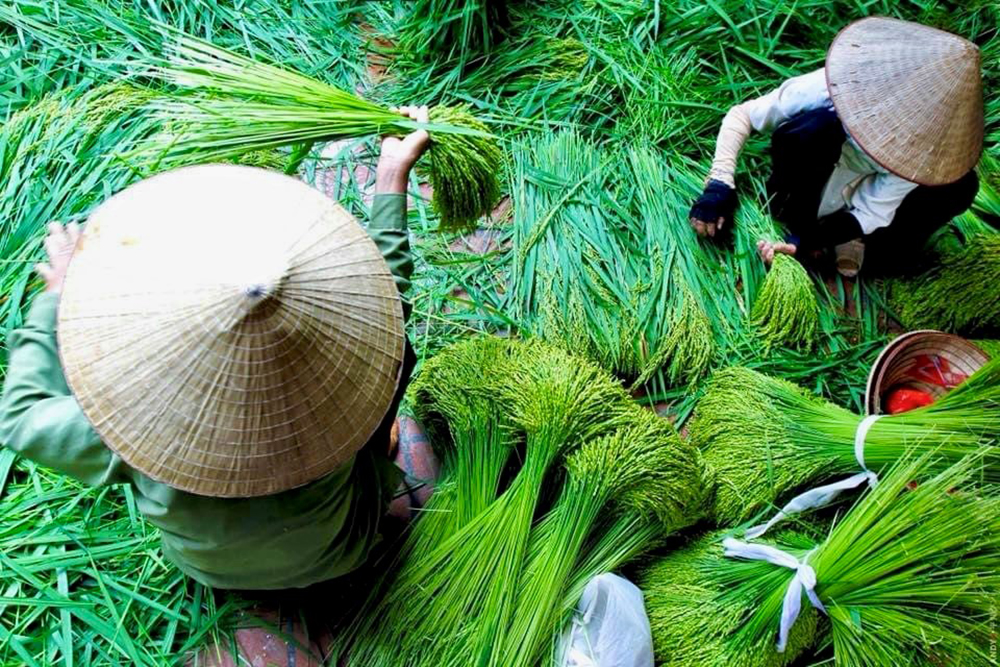
After roasting, the cốm is finely ground and mixed with sugar, and sometimes a hint of pandan leaves is added for extra appeal. Finally, the cốm is wrapped in lotus or banana leaves, creating an attractive presentation while preserving its fragrance.
Cốm Vòng has a sweet, rich flavor and a delightful aroma, often enjoyed with bananas or used to make cốm cakes. This delicacy is not just a snack; it carries memories and flavors of childhood. People in Hanoi often enjoy cốm in the morning or afternoon, paired with tea, creating a unique culinary experience.

The Cốm Vòng village is not only a source of pride for the people of Hanoi but also an integral part of Vietnam’s culinary heritage. With its delicious flavor and unique production process, Cốm Vòng continues to win the hearts of many generations, preserving the cultural values and traditions of the country.
8. Sơn Đồng Sculpture Village
Sơn Đồng is renowned for its wood carving craftsmanship, producing artistic works deeply rooted in spirituality and belief. The products from this village are not only beautiful but also carry profound cultural significance.
With a long history, Sơn Đồng has maintained a wood carving tradition for hundreds of years. This craft has been passed down through generations, with artisans continuously developing their techniques and styles. The earliest works primarily served religious and worship needs, reflecting the spiritual and cultural essence of the Vietnamese people.

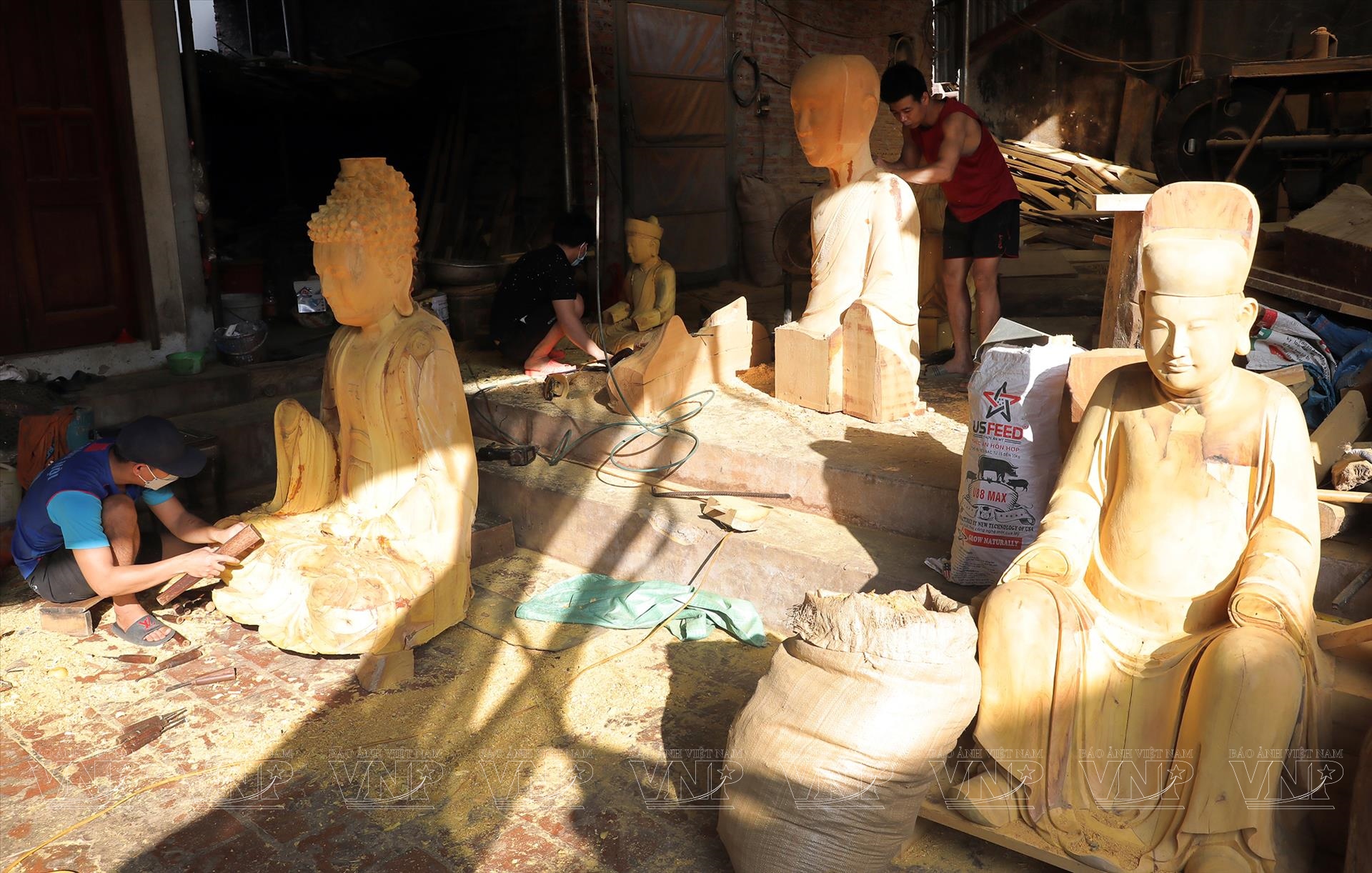
The wood carvings from Sơn Đồng are quite diverse, ranging from Buddha statues and deities to interior decorations and gifts. These works not only hold artistic value but also carry deep spiritual significance, often used in religious ceremonies and to enhance living spaces. Buddha statues and other religious symbols reflect the respect and devotion of the people towards their beliefs.
9. Đào Thục Water Puppet Village
Đào Thục village preserves the art of water puppetry, a unique and richly artistic form of entertainment that has contributed to promoting Vietnamese culture worldwide.
Originating from the rural areas of Northern Vietnam, Đào Thục is one of the prominent cradles of this art form. Water puppetry began to flourish in the 11th century and was used during festivals, particularly to pray for a bountiful harvest and to ward off evil spirits. Over time, water puppetry has become an integral part of the cultural life of the local people.
Water puppetry is a perfect blend of music, acting, and visual art. The artisans of Đào Thục undergo years of rigorous training to master the skill of controlling the puppets. Each performance typically takes place on water, featuring intricately crafted wooden puppets that vividly portray characters and landscapes.
Traditional instruments, such as drums, đàn bầu, and flutes, create a lively atmosphere for the performances. The stories told through water puppetry often reflect daily life, legends, and customs of the Vietnamese people.

The Đào Thục Water Puppet Village is not only a guardian of a unique traditional art form but also a symbol of Vietnamese culture. With its fusion of performing arts, music, and visual imagery, Đào Thục water puppetry has played a significant role in promoting Vietnamese culture globally, affirming the value of this precious cultural heritage.

10. Chuôn Ngọ Mother-of-Pearl Inlay Village
Chuôn Ngọ village has a long-standing tradition that dates back to the 17th century. The craft of mother-of-pearl inlay began with the decoration of household items and gradually evolved into a unique art form. The artisans here have preserved and developed this craft, passing it down through generations, enriching the artistic culture of Vietnam.
The inlay process involves several intricate and meticulous steps. First, artisans select high-quality wood, cut it, and shape the product according to a design template. Next, natural mother-of-pearl pieces, typically sourced from shells, are cut into small shapes and carefully arranged on the wooden surface.
Each mother-of-pearl piece requires high precision, from color selection to the arrangement of the inlays, ensuring harmony and aesthetic appeal. Once completed, the product is coated with a protective layer to maintain its durability and color over time.
Traditional craft villages like Vạn Phúc Silk Village, Quất Động Embroidery Village, Cốm Vòng Village, Sơn Đồng Wood Carving Village, Đào Thục Water Puppet Village, and Chuôn Ngọ Mother-of-Pearl Inlay Village are not only distinctive cultural symbols of Vietnam but also vital for preserving artistic values and customs. The artisans here create beautiful products that convey the soul and identity of the nation through each piece. Preserving and promoting these traditional crafts will enrich the country’s cultural heritage and create economic opportunities for the community.
Hanoi Larosa Hotel
Hanoi Larosa Hotel is an excellent choice for travelers visiting Hanoi. Located in a prime area, the hotel is just a few minutes’ walk from famous attractions like Hoan Kiem Lake, the Opera House, and the Old Quarter. With its modern and luxurious design, Hanoi Larosa provides guests with the most comfortable and convenient experiences.
The hotel offers various amenities, including well-equipped rooms, a restaurant serving diverse cuisines, a spa service, and a gym. The professional and friendly staff are always ready to assist, ensuring that all guest needs are met.
In addition to enjoying premium services, the hotel offers guests opportunities to explore the local culture through tours, cultural exchanges, and traditional cuisine tastings. This allows visitors not only to relax but also to gain a deeper understanding of the cultural beauty of Hanoi.

Hanoi Larosa Hotel
Hanoi Larosa Hotel is not only an ideal stop for travelers but also a destination to explore the culture and people of Hanoi. With a combination of excellent service and rich cultural experiences, Hanoi Larosa promises to provide you with memorable moments during your journey through the capital.
Contact Information
- Address: 36 Nguyễn Khuyến, Hà Nội
- Phone: +84 243 747 1155
- Email: info@hanoilarosahotel.com
- Website: www.hanoilarosahotel.com
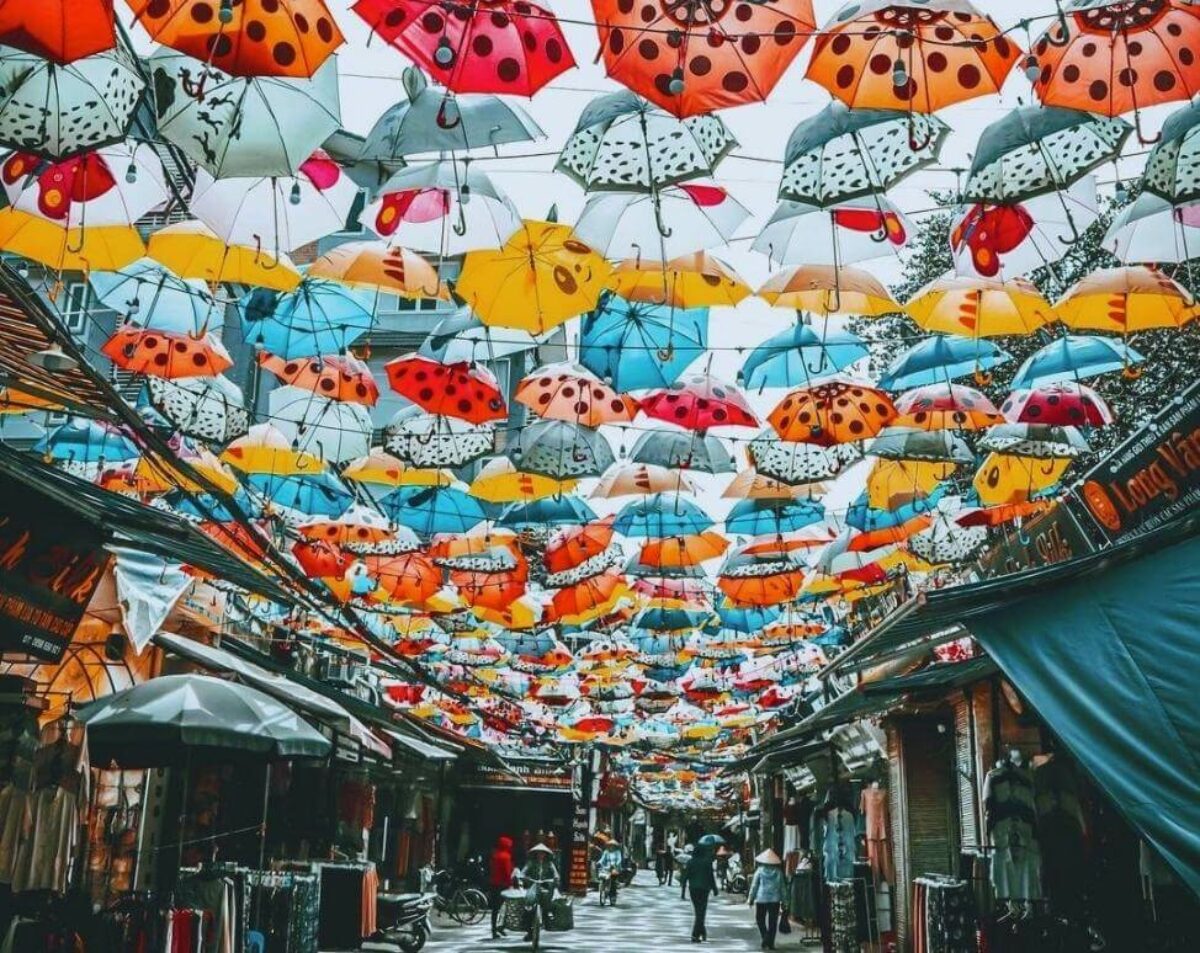
0 Comments